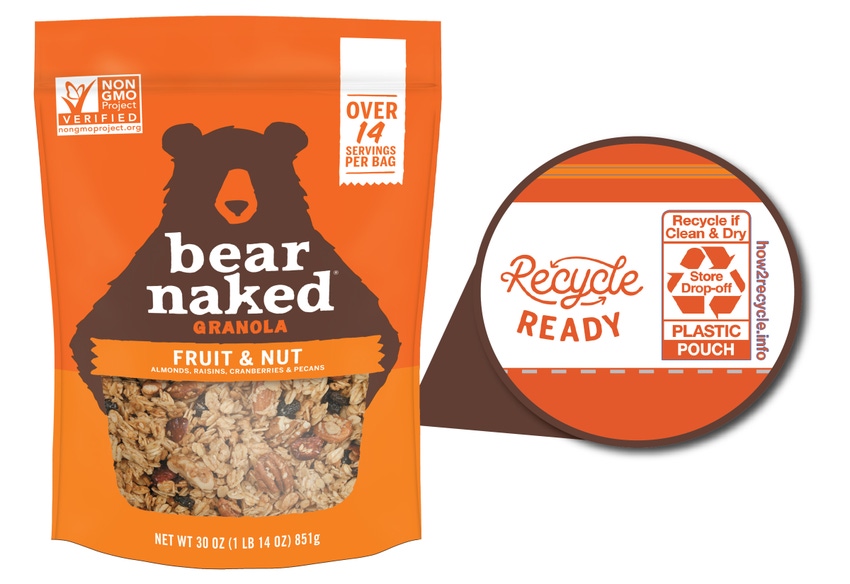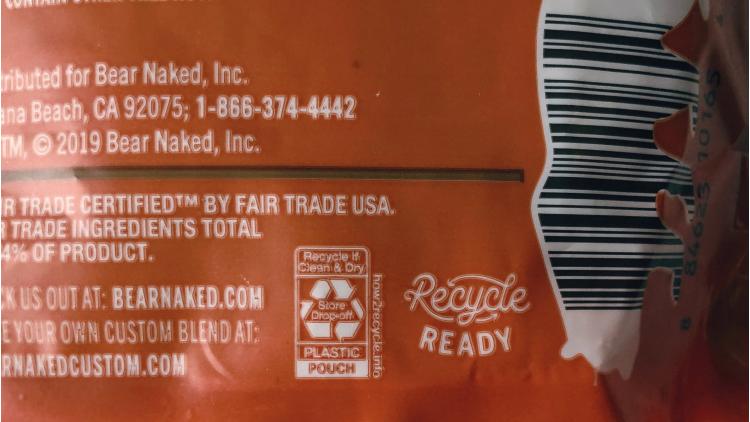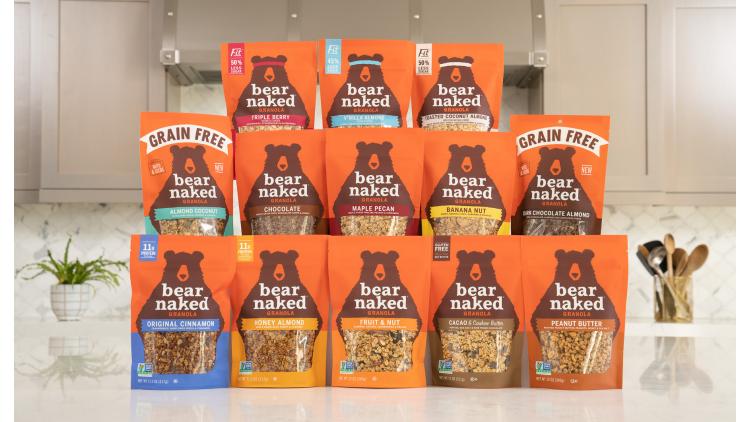Kellogg’s Bear Naked cereal pouches embrace recyclability
February 18, 2020

Lead engineer Shannon Moore shares an insider’s view of the development including the considerations, what was learned, advice and more.
Consumers have always loved convenience in the packaged products they purchase and nowadays it’s important that packaging not only be recyclable, it should be convenient to recycle, too.
It’s something that Kellogg’s Solana Beach, CA-based Bear Naked Inc. granola company took seriously. After 18 months’ development the brand stakes a claim as the first fully recyclable stand-up barrier pouch made for food packaging that’s available nationwide. The previous pouch structure was recyclable, but the process wasn’t efficient or convenient: recycling required customers to sign up for a special program to ship the packaging for recycling; now, the packaging can be recycled using convenient at-store drop-off locations.
Kellogg’s lead packaging engineer, Shannon Moore, was deeply involved in the development in which the company worked with partners to develop a barrier recyclable film that could meet the brand’s technical and marketing requirements. Moore’s four years’ experience at the company followed 10 years��’ work at Procter & Gamble that involved various roles in supply chain and package development on household and personal care brands.
The recyclable pouch rollout involves all of Bear Naked core product lines of granola and bites, according to Moore, some 13 product lines in all. “All of the granola has already converted over and we are currently in the process of rolling it out on our bites,” she tells Packaging Digest. The rest of our interview follows.
What’s this about?
Moore: Bear Naked granola wanted to increase their sustainability efforts within packaging by creating a more sustainable pouch. This required development of strategic partnerships across the value chain, from resin to manufacturing. Together, the team worked to design the Recycle Ready pouch for launch in 2019. This is just one part of the overall journey of sustainability for this brand and Kashi as part of Kellogg’s sustainability commitments for 2025.
How was the packaging changed?
Moore: The previous structure was a multilayer PET/polyethylene film. The new film is mono-material PE with ethylene vinyl alcohol barrier. The pouch size and the net weight did not change.
What were the marketing and technical considerations?
Moore: We surface print with a matte appearance and have a window on the front of the pouch. Marketing requirements meant that we had to ensure that these elements were maintained. We had to also maintain our existing shelf life in the new film, which appears on the pouch bottom.

How was the previous package disposed of and what’s done now?
Moore: The packaging was either sent to TerraCycle or landfilled. Now the film can be dropped off at stores and retailers into the store drop-off recycling stream. The pouches are printed with the How2Recycle label information, which appears along the back panel bottom next to a “Recycle Ready” callout.
Next: Vendors, challenges, lessons learned, advice
Vendors Berry Global (film), Fresh-Lock (zipper), Dow (resins) and ColorMasters (printing/converting) were all involved…how unusual is this?
Moore: Our manufacturing partner Hearthside Foods was involved on this from a production standpoint. I led the team collaboration with the vendors, which included in-person on-site development work both at Kellogg’s, the suppliers and at Dow. This is atypical of a packaging change project because for this project we involved the resin supplier.
What else was different about the project?
Moore: It was managed end-to-end from the resin manufacturing all the way through to the transportation and customer involvement. It involved a lot of collaboration and partnership between the different players depending on their place in the supply chain.

What was the biggest challenge?
Moore: Compatibility of the film with our existing equipment and ensuring that we maintained the same look and feel of the brand.
Please comment on the R&D timetable.
Moore: The project took about 18 months’ time; validation and shelf-life testing took the longest portion of that time.
What’s been the reception?
Moore: It has been positive feedback. The pouch was the recipient of the 2019 Technology Excellence Award in Snack and Bakery during Pack Expo in September 2019. In January 2020, the pouch was chosen for a Silver Award in Sustainability in the Flexible Packaging Assn.’s 2020 FPA Achievement Awards
What’s a lesson learned you can share?
Moore: Involvement and engagement from all parts of the material spectrum is very important when designing for sustainability.
What advice do you have for other brands and engineers working in flexible packaging?
Moore: With regards to sustainable packaging—there is no one size fits all, it’s really important to understand your consumers’ needs, the level of understanding they have around sustainable packaging and what your vendor partners capabilities are. Also, having a good understanding of the recycling infrastructure in your area or country is important from a design aspect.
What was the most personally gratifying experience from this project?
Moore: Being able to be a part of an important goal for the brand and being able to see it from initial ideation to launch.
Final thoughts?
Moore: This was a very intense project to lead, but if you were to ask anyone on the team, the one theme you would hear is that everyone gained a deep knowledge about another area of the packaging value chain that they didn’t have previously. We will all use the experience to help further sustainable packaging design in future project work.
|
You May Also Like


